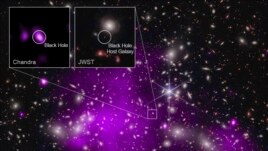08 November 2023
Scientists have discovered the oldest black hole yet.
The huge object formed about 470 million years after the Big Bang, researchers said.
The study was published recently in Nature Astronomy. The researchers said the findings confirm their theory: Supermassive black holes existed in the very early universe. The United States space agency, NASA, used its James Webb Space Telescope and Chandra X-Ray Observatory over the past year to make the observations.

This annotated image provided by NASA on Nov. 6, 2023, shows a composite view of data from NASA's Chandra X-ray Observatory and James Webb Space Telescope indicating a growing black hole just 470 million years after the big bang. (NASA via AP)
If the universe is 13.7 billion years old, the age of this black hole would be 13.2 billion years.
The scientists said that this oldest black hole is extremely massive — 10 times bigger than the black hole in our own Milky Way galaxy.
It is believed to weigh anywhere from 10 percent to 100 percent the mass of all the stars in its galaxy, said the study's lead writer Akos Bogdan of the Harvard-Smithsonian Center for Astrophysics. That is far larger than all the black holes in our Milky Way and its closer galactic neighbors, he noted. Their mass on average is only about one-tenth of a percent of that of the stars in their galaxies.
"It's just really early on in the universe to be such a behemoth," said Yale University's Priyamvada Natarajan, a study team member. The Astrophysical Journal Letters published a report linked to the study.
"It's astounding how this thing actually is sitting in place already with its galaxy so early on in the universe," Natarajan said.
The researchers believe the black holes formed from huge clouds of gas that collapsed in a galaxy next to another with stars. The two galaxies joined, and the black hole was in control.
The Chandra telescope found the object with X-ray imaging. That fact confirms "without a doubt that it is a black hole," Natarajan said. With X-rays "you're actually capturing the gas that is being gravitationally pulled into the black hole, sped up and it starts glowing in the X-rays," she said.
Natarajan also said this black hole is considered a quasar since it is actively growing, and the gas is extremely bright.
In addition to the latest find, scientists said the Webb telescope might have found a black hole that is 29 million years older. However, that object still needs to be observed in X-rays to be confirmed. Natarajan expects more early black holes will be found — perhaps not as far away, but still very distant.
"We are expecting a new window to open in the universe, and I think this is the first crack," she said.
The two space telescopes — Webb and Chandra — were able to observe the part of space that holds this galaxy, UHZ1, and its black hole because of what is called "gravitational lensing." The gravity of a galaxy much closer to Earth magnified the apparent image of UHZ1 and its black hole, which are further in the background.
"It's a pretty faint object, and thanks to...luck, nature has magnified it for us," Natarajan said.
NASA launched the Webb telescope in 2021 to a point 1.6 million kilometers away from Earth. It is the biggest and most powerful observatory ever sent into space. Webb captures images of the universe in infrared light. The much older Chandra records X-ray radiation. It was sent into orbit in 1999.
"I absolutely find it amazing that Chandra can do such amazing discoveries 24 years after its launch," Bogdan said.
I'm Caty Weaver.
The Associated Press reported this story. Caty Weaver adapted it for VOA Learning English.
_____________________________________________________
Words in This Story
behemoth –n. something very big and powerful
glowing –adj. shining with a steady, warm light
quasar –n. a powerful source of radio waves that is very distant
crack –n. a long thin break in something
magnify –v. the property of making something look closer than it actually is
faint –adj. not bright; hard to see
amazing –adj. wonderful; very interesting